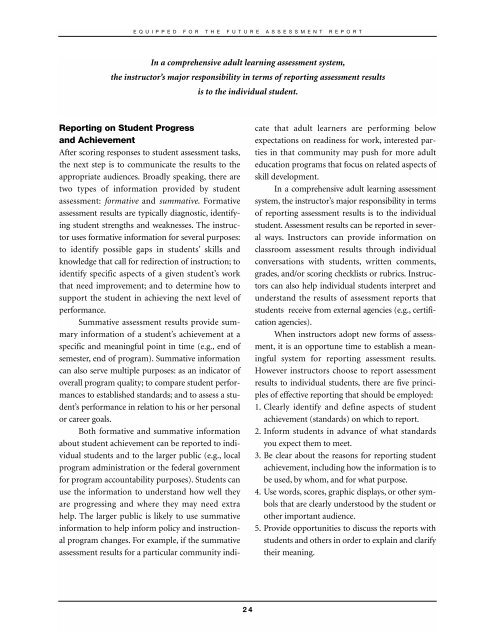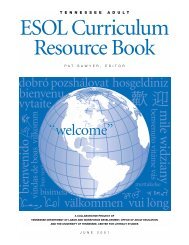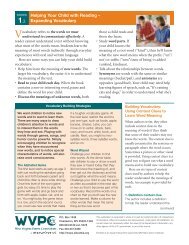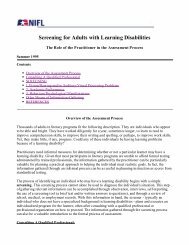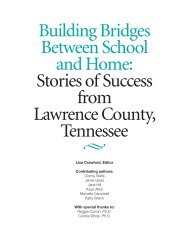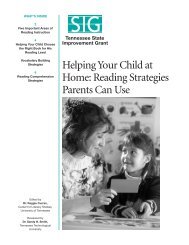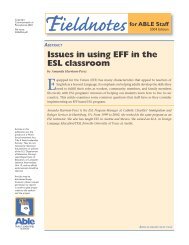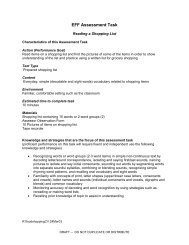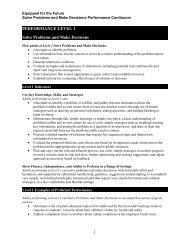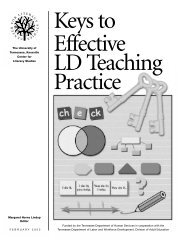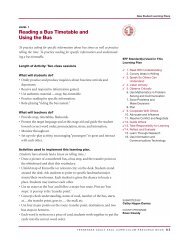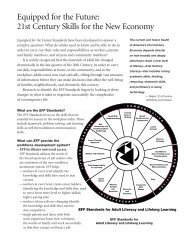Equipped for the Future Assessment Report: How Instructors Can ...
Equipped for the Future Assessment Report: How Instructors Can ...
Equipped for the Future Assessment Report: How Instructors Can ...
You also want an ePaper? Increase the reach of your titles
YUMPU automatically turns print PDFs into web optimized ePapers that Google loves.
E Q U I P P E D F O R T H E F U T U R E A S S E S S M E N T R E P O R T<br />
In a comprehensive adult learning assessment system,<br />
<strong>the</strong> instructor’s major responsibility in terms of reporting assessment results<br />
is to <strong>the</strong> individual student.<br />
<strong>Report</strong>ing on Student Progress<br />
and Achievement<br />
After scoring responses to student assessment tasks,<br />
<strong>the</strong> next step is to communicate <strong>the</strong> results to <strong>the</strong><br />
appropriate audiences. Broadly speaking, <strong>the</strong>re are<br />
two types of in<strong>for</strong>mation provided by student<br />
assessment: <strong>for</strong>mative and summative. Formative<br />
assessment results are typically diagnostic, identifying<br />
student strengths and weaknesses. The instructor<br />
uses <strong>for</strong>mative in<strong>for</strong>mation <strong>for</strong> several purposes:<br />
to identify possible gaps in students’ skills and<br />
knowledge that call <strong>for</strong> redirection of instruction; to<br />
identify specific aspects of a given student’s work<br />
that need improvement; and to determine how to<br />
support <strong>the</strong> student in achieving <strong>the</strong> next level of<br />
per<strong>for</strong>mance.<br />
Summative assessment results provide summary<br />
in<strong>for</strong>mation of a student’s achievement at a<br />
specific and meaningful point in time (e.g., end of<br />
semester, end of program). Summative in<strong>for</strong>mation<br />
can also serve multiple purposes: as an indicator of<br />
overall program quality; to compare student per<strong>for</strong>mances<br />
to established standards; and to assess a student’s<br />
per<strong>for</strong>mance in relation to his or her personal<br />
or career goals.<br />
Both <strong>for</strong>mative and summative in<strong>for</strong>mation<br />
about student achievement can be reported to individual<br />
students and to <strong>the</strong> larger public (e.g., local<br />
program administration or <strong>the</strong> federal government<br />
<strong>for</strong> program accountability purposes). Students can<br />
use <strong>the</strong> in<strong>for</strong>mation to understand how well <strong>the</strong>y<br />
are progressing and where <strong>the</strong>y may need extra<br />
help. The larger public is likely to use summative<br />
in<strong>for</strong>mation to help in<strong>for</strong>m policy and instructional<br />
program changes. For example, if <strong>the</strong> summative<br />
assessment results <strong>for</strong> a particular community indicate<br />
that adult learners are per<strong>for</strong>ming below<br />
expectations on readiness <strong>for</strong> work, interested parties<br />
in that community may push <strong>for</strong> more adult<br />
education programs that focus on related aspects of<br />
skill development.<br />
In a comprehensive adult learning assessment<br />
system, <strong>the</strong> instructor’s major responsibility in terms<br />
of reporting assessment results is to <strong>the</strong> individual<br />
student. <strong>Assessment</strong> results can be reported in several<br />
ways. <strong>Instructors</strong> can provide in<strong>for</strong>mation on<br />
classroom assessment results through individual<br />
conversations with students, written comments,<br />
grades, and/or scoring checklists or rubrics. <strong>Instructors</strong><br />
can also help individual students interpret and<br />
understand <strong>the</strong> results of assessment reports that<br />
students receive from external agencies (e.g., certification<br />
agencies).<br />
When instructors adopt new <strong>for</strong>ms of assessment,<br />
it is an opportune time to establish a meaningful<br />
system <strong>for</strong> reporting assessment results.<br />
<strong>How</strong>ever instructors choose to report assessment<br />
results to individual students, <strong>the</strong>re are five principles<br />
of effective reporting that should be employed:<br />
1. Clearly identify and define aspects of student<br />
achievement (standards) on which to report.<br />
2. In<strong>for</strong>m students in advance of what standards<br />
you expect <strong>the</strong>m to meet.<br />
3. Be clear about <strong>the</strong> reasons <strong>for</strong> reporting student<br />
achievement, including how <strong>the</strong> in<strong>for</strong>mation is to<br />
be used, by whom, and <strong>for</strong> what purpose.<br />
4. Use words, scores, graphic displays, or o<strong>the</strong>r symbols<br />
that are clearly understood by <strong>the</strong> student or<br />
o<strong>the</strong>r important audience.<br />
5. Provide opportunities to discuss <strong>the</strong> reports with<br />
students and o<strong>the</strong>rs in order to explain and clarify<br />
<strong>the</strong>ir meaning.<br />
24


